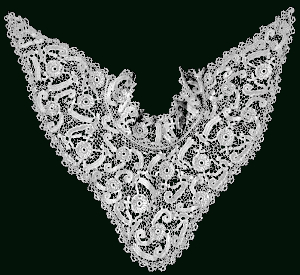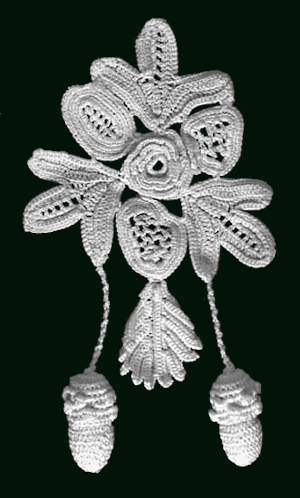
The mid-1800s found Ireland in the midst of a devastating "famine." A potato blight had obliterated the agricultural mainstay of the nation. The country was in desperate need of a lucrative commodity to lift it out of its declining state. Lace-making was a profitable business, but the traditional methods were too slow to afford the quick relief that the country needed.
In an effort to copy the treasured and exquisite forms found in the valued Venetian Needle lace and the more delicate filigree of Rosaline lace, emerged a distinctive style of crochet that proved to be both quick and profitable. It soon became known as "Pt. d'Irlande" in the countries who sought its beauty.
 It is a style that has earned the right to stand alone, a thing of beauty, to be admired, coveted and collected by the best of collectors. Its delicate filigree and bold relief still speak of dedication, skill and the desire for a better life.
It is a style that has earned the right to stand alone, a thing of beauty, to be admired, coveted and collected by the best of collectors. Its delicate filigree and bold relief still speak of dedication, skill and the desire for a better life.

It is generally accepted that it was Mademoiselle Riego de la Blanchardiere who invented the now famous style. She published the first book of Irish Crochet patterns in 1846. It was used and referred to by both the schools of crochet that sprang up and by the ever-growing Irish cottage industry.
The distinctive feature of Irish Crochet is its separate motifs joined by either filigree mesh or crocheted bars. Stylized motifs of flowers, shamrocks, and grapevines are arrayed in splendor. It is an artistic mode of crochet that lends itself well to the creative mind.

IRISH CROCHET HIGH NECK COLLAR
The floral motifs have
superimposed cord padded centers. 19th c.
JAE.13453
A cord padding is often incorporated into the motif and by carefully adjusting the tightness and the amount of stitches, the stems, leaves and flowers can be artistically manipulated to add 'life' to the objects. The pattern is meant merely as a structural skeleton, much is left to the imagination of the worker.
Two people, making the same motif, can turn out vastly different products. It is the creative spirit and thoughtful eye that enabled someone to manipulate the pattern to instill vitality into the growing work.
Crochet itself was well adapted to the rigorous life of the peasant people. Cotton thread was cheap and easily laundered. The technique required only the crudest of handmade tools: the crochet hook. The labor could be done either by the light of day, or in the dim glow of a peat fire lamp helped by a glass globe of water to reflect back what little light it shed. The lace often became dirty in the harsh conditions of poverty and had to be washed before it was sold. Particularly fastidious workers would wrap the work in progress and put it under their bed at night. This practice became known as "bedding the work."

The labor soon became a family occupation.
Young and old, women as well as men turned to this new industry to provide life's sustenance. Within Ireland itself, the lace became known as "relief lace." A division of labor sprang up. The technique adapted will to all levels of ability. Everyone in the family could contribute to the finished piece. One person might make the same motif over and over. The more difficult patterns were left to the nimblest of hands, while those less agile and creative could work the simpler leaves and stems. The motifs were brought by foot to a lace-making center in the town. There they were arranged in a studied manner and crocheted together to form everything from collars and cuffs to bodices, dresses and coats.

|
From a wellspring of ingenuity, perseverance and community cooperation the
lace industry flourished for a time. It served as a vital cottage industry throughout the famine. It not only fed the people, but preserved their dignity... and the world took notice. Martha Sherick Shen, 2005 |

Irish Crochet: 150 Years of a Tradition | Slideshow | Exhibit Brochure | Press | Photos from the Opening Event
